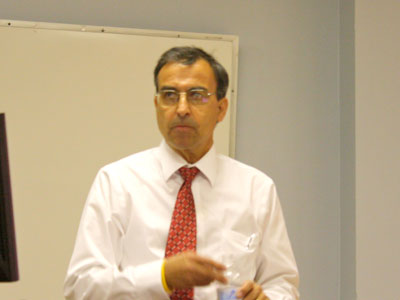Beakers fly from shelves, equipment rattles across the floor, and chemicals spill over the counters. All of these things may come to mind when thinking of “Rumbles in the Laboratory,” as may any number of other things. However, last week’s Heiland Lecture focused solely on geophysics, not greenhouse gasses.
Dr. Carl Sondergeld, associate dean of the Mewbourne School of Petroleum and Geological Engineering at Oklahoma University, shared his own lab shaking experiences to the audience. “A lot of our working knowledge of geophysics comes from empirical knowledge.” He repeatedly pointed out that a majority of the relevant literature on the subject of seismic studies is from the 1940s through the 1970s. What has changed, more than anything, is the means by which new geophysicists can collect data and share it with others. It has likely changed the game more than anything as technology has progressed in recent decades from analog to digital equipment. “In the old days we bought pulse amplifiers from the military… we bought oscilloscopes from the military… all of this was surplus, of course, because we were poor.” Sondergeld further stressed the convenience of moving away from live data collection, “With the [analog] oscilloscopes, if you did not make your observation, the data was gone… So we spent a lot of time in the lab… We did a lot of sleeping in the lab”
After reminiscing about the days of analog circuitry, Sondergeld discussed some of the experiments done over the past century that actually provide the empirical data used today. One of the studies that Sondergeld discussed was wave velocity versus porosity in various media, both man-made and natural. He showed that there was a very linear drop in velocity as the porosity of the media was increased, but only in the man-made materials of aluminum oxide and sintered glass.
For natural materials, however, the core samples showed much less consistent data. Sonderfeld explained that this exemplified the nature of the problems in dealing with real materials. “Nature is pretty ugly… it never applies the way we want it to when we want it to.”
Sonderfeld then shared further studies done over the past 50 years relating wave velocities to other criteria. It was shown that increased clay content, cracks, and organic content, in addition to porosity, all contribute to lower P and S wave velocities through media.
Sonderfeld concluded the lecture by discussing the future of seismic studies within the laboratory. One of the most interesting challenges facing the newest generation of geophysicists is the use of technology to probe porosity. The equipment available to researchers today vastly out performs what was available mere years ago, as was clearly shown in a video of some of Sonderfeld’s work at the University of Oklahoma. The University’s setup allowed a series of scanning electron microscope (SEM) images to be taken of a block of material. In each successive image, a further 10 nm of material was removed, and when the images were played in series, the change in porosity can be clearly seen. With the images, 3D representations of the material and porosity can be predicted with greater accuracy than ever.
As with every scientific field, technology is constantly changing the game, and even in the world of rocks and minerals, better ways of vibrating them can always be found.



'Heiland Lecture: Royal rumble in the laboratory jungle' has no comments
Be the first to comment this post!